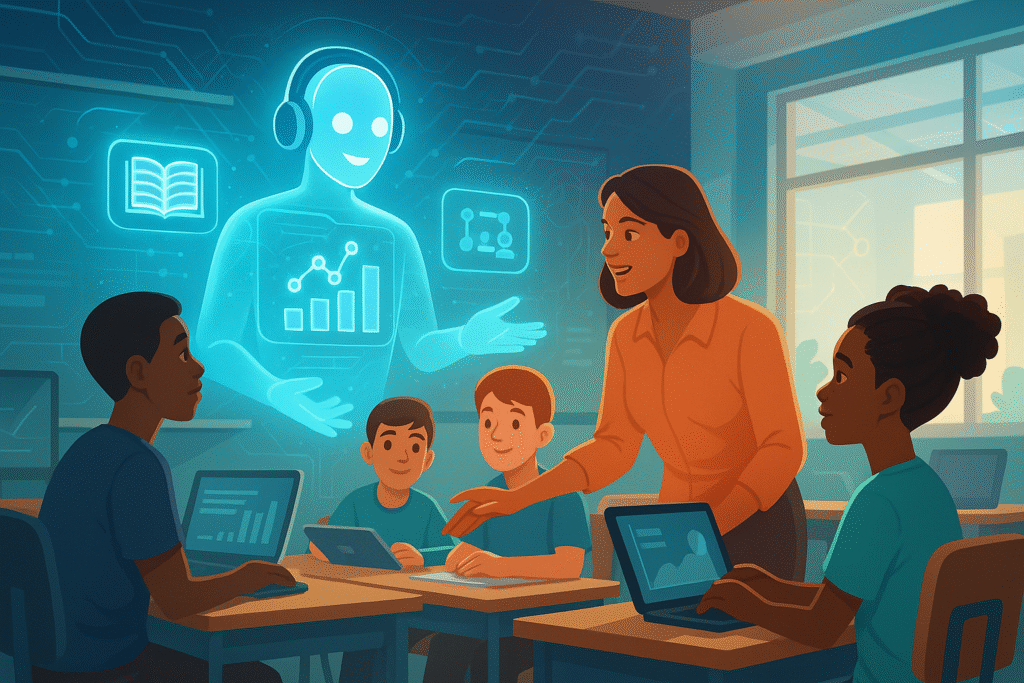“Explore how an AI agent for education transforms teaching and learning, personalizing student experiences and automating tasks for a smarter classroom future.”
The education landscape is shifting, and AI agents are at the forefront of this change. These intelligent digital assistants are more than just tools; they’re becoming integral partners for educators and students. They’re reshaping how we approach teaching, making learning more personal, and even taking over those time-consuming tasks that often bog down teachers. This article will explore the top seven ways AI agents make a real difference in classrooms, providing practical examples and actionable insights.

The Dawn of a New Educational Era with AI Agents
For years, educators have grappled with the challenge of providing individualized attention to every student. Class sizes, diverse learning styles, and administrative burdens often make this daunting. Enter AI agents. These sophisticated software systems can analyze vast amounts of data, make informed decisions, and carry out tasks with a level of autonomy that was once the stuff of science fiction. They learn from every interaction, constantly adapting to learners’ unique needs and the classroom’s dynamic environment.
The impact of AI agents on teaching and learning is profound. They’re not just incremental improvements; they’re addressing long-standing issues in education that have persisted for decades. By taking on specific responsibilities, AI agents free up teachers to do what they do best: inspire, mentor, and connect with students on a deeper level. Let’s delve into the specific ways these intelligent agents are revolutionizing education.
1. Truly Personalized Learning Experiences
Agents bring one of the most significant breakthroughs to education: the ability to deliver genuinely personalized learning. Consider a classroom with 30 students with different strengths, weaknesses, and learning preferences. It’s almost impossible for a single teacher to effectively cater to all of them. This is where AI agents shine.
How it Works: AI agents can analyze students’ performance data, learning pace, areas where they struggle, and even their preferred way of processing information. Based on this analysis, they can adjust the content, the speed of delivery, and the instructional methods to fit that individual student perfectly. Imagine an adaptive curriculum designer that constantly tweaks a student’s learning path, making sure they’re challenged without being overwhelmed. It’s about ensuring no student falls behind or is held back unnecessarily.
Real-World Example: Consider an intelligent tutoring system. This isn’t just a multiple-choice quiz; it’s a digital tutor that provides one-on-one guidance. If a student consistently misunderstands a particular concept in algebra, the AI tutor won’t just mark it wrong. Instead, it might offer alternative explanations, break down the problem into smaller steps, or suggest supplementary resources like videos or interactive simulations. The system constantly adjusts the difficulty level, offering targeted practice and immediate, personalized feedback. This continuous adaptation ensures that each student receives the precise support they need, when they need it, leading to a much deeper understanding of the material.
Actionable Insight: Educators can begin integrating personalized learning platforms powered by AI. Start with a pilot program in a specific subject. Monitor student engagement and progress closely. Look for platforms that offer detailed analytics, providing insights into individual student needs that can inform your teaching strategies. Focus on using these tools to supplement your instruction, allowing you to dedicate more time to complex problem-solving and critical thinking activities with students.
2. Automating Repetitive Administrative Tasks
Teaching isn’t just about delivering lessons; it involves a mountain of administrative work. Grading papers, scheduling appointments, sending reminders, and managing discussions consume a massive chunk of an educator’s time, often taking away from direct student interaction. AI agents are game-changers in this area, significantly reducing the administrative burden.
How it Works: AI agents can handle many routine, repetitive tasks that traditionally fall on teachers. These include automated grading of certain assignment types, generating basic content or lesson plans, scheduling parent-teacher conferences, and tracking student progress with precision. By offloading these duties, teachers gain valuable time back in their day.
Real-World Example: Picture a virtual teaching assistant. This AI agent can manage routine student inquiries, such as questions about assignment deadlines or general course information. It can also facilitate discussion forums, prompting students with questions, summarizing key points, and even identifying areas where students might struggle based on their contributions. For educators, this means less time answering the same questions repeatedly and more time focusing on complex teaching responsibilities like designing engaging projects or providing in-depth feedback on essays. Automated assessment tools can grade multiple-choice tests or even analyze written responses for keywords and conceptual understanding, providing instant feedback to students and detailed reports to teachers.
Actionable Insight: Explore AI-powered tools designed for administrative support in education. Many learning management systems (LMS) are now integrating AI features for automation. Identify your role’s most time-consuming administrative tasks and research AI solutions to automate them. Start small, using an AI tool for automated grading of basic quizzes, and gradually expand its use as you become more comfortable. This efficiency can also enable schools and organizations to scale their learning programs more effectively without compromising quality or overstretching resources.
3. Boosting Classroom Engagement Through Dynamic Content
Engaging students, especially in an era of constant digital distraction, is a perpetual challenge. Static textbooks and one-size-fits-all lessons often fail to capture the attention of diverse learners. AI agents are changing this by creating more dynamic and responsive learning environments.
How it Works: AI agents can adapt course materials to different learning styles. They can transform text into interactive simulations, generate practice problems on the fly, or even create personalized quizzes based on a student’s prior performance. This adaptability keeps learners hooked, as the content always feels relevant and challenging.
Real-World Example: Imagine an AI-powered teaching aid that monitors student attention and comprehension during a lesson. Suppose it detects that several students are struggling with a particular concept. In that case, it might automatically suggest a short video explanation, a different example, or an interactive exercise to reinforce the idea. In a language learning context, an AI agent could generate conversations tailored to a student’s proficiency level, providing real-time feedback on pronunciation and grammar, making the learning process more interactive and less intimidating. This real-time feedback and dynamic content generation lead to higher learner satisfaction and better educational results.
Actionable Insight: Investigate AI tools specializing in interactive content creation or adaptive learning modules. Look for platforms that integrate seamlessly with your existing teaching tools. Encourage students to interact with these AI-powered resources for self-study and practice. Observe how the dynamic content affects student participation and enthusiasm in the classroom, and use this feedback to refine your approach.
4. Intelligent Tutoring and Academic Support
The dream of having a personalized tutor for every student is becoming a reality with intelligent tutoring systems (ITS) powered by AI agents. These systems go far beyond simple drills and practice.
How it Works: ITS platforms offer one-on-one guidance like a human tutor. They analyze students’ responses, identify misconceptions, and provide targeted explanations and hints. They don’t just tell students they’re wrong; they help them understand why they’re bad and guide them toward the correct solution. The AI continually adjusts the difficulty of problems and the type of support offered based on the student’s evolving needs.
Real-World Example: Consider an ITS used in mathematics. The AI agent can detect this pattern if a student consistently makes a specific error when solving quadratic equations. Instead of marking the problem, it might provide a mini-lesson on that particular step, offer scaffolding to break it down, or present similar issues focusing on that common mistake. This highly concentrated support helps students overcome individual academic hurdles effectively. Another example is AI-powered writing assistants that can review student essays, provide feedback on grammar, style, and logical flow, and help students refine their writing skills autonomously.
Actionable Insight: Explore intelligent tutoring systems available for your subject area. Consider implementing an ITS as a supplemental resource for students who require extra support or accelerated learning. Encourage students to use these systems for self-paced learning and review. Collect data on student performance within the ITS to identify common areas of difficulty for the entire class, which can inform your whole-group instruction.
5. Streamlining Content Creation and Curation
Developing engaging and relevant educational content is a time-consuming process for educators. From designing lesson plans to finding appropriate resources, it demands significant effort. AI agents can significantly streamline this by assisting with content creation and curation.
How it Works: AI agents can generate initial drafts of lesson plans, create diverse question banks, or even curate relevant articles, videos, and interactive exercises from the vastness of the internet. They can quickly identify high-quality resources tailored to specific learning objectives or student age groups, saving educators countless hours of searching.
Real-World Example: An educator needs to create a new module on climate change. Instead of starting from scratch, an AI agent can generate a preliminary lesson outline, suggest key topics, and even pull together a list of reputable scientific articles, documentaries, and interactive simulations related to the subject. The teacher can then refine and personalize this content, adding their unique insights and tailoring it to their students’ needs. Similarly, for assessment, an AI agent can generate multiple versions of a quiz on the same topic, reducing the chance of cheating and providing varied practice opportunities.
Actionable Insight: Experiment with AI tools that offer content generation capabilities. While AI can create initial drafts, educators must review, edit, and personalize the generated content to ensure accuracy, relevance, and alignment with pedagogical goals. Use these tools as a starting point to boost your productivity in content development, allowing you to focus on higher-order tasks like designing unique projects or facilitating deep discussions.
6. Enhancing Administrative and Operational Support for Institutions
Beyond the classroom, AI agents are also transforming the operational backbone of educational institutions. These intelligent systems can improve efficiency and data-driven decision-making in areas ranging from admissions to facilities management.
How it Works: AI agents can automate processes like managing student applications, handling enrollment inquiries, optimizing resource allocation (e.g., classroom scheduling), and predicting student retention rates based on various data points. This operational efficiency can lead to better resource utilization and an improved experience for students, faculty, and staff.
Real-World Example: In a university admissions office, an AI agent can process thousands of applications, verify documents, check prerequisites, and even flag applications that require special attention based on predefined criteria. This significantly speeds up the admissions process and reduces human error. Another example is an AI-powered system that manages school transportation, optimizing bus routes and schedules based on real-time traffic data and student locations, leading to more efficient and timely transport. AI can also assist in maintaining infrastructure by predicting potential equipment failures based on usage data, allowing for proactive maintenance rather than reactive repairs.
Actionable Insight: For educational leaders and administrators, explore how AI can be integrated into existing Enterprise Resource Planning (ERP) systems or Student Information Systems (SIS). Identify areas within your institution that are bottlenecks due to manual processes and research AI solutions that can automate or optimize these operations. Consider a phased implementation, starting with less critical functions and scaling up as confidence and expertise grow.
7. Democratizing Education and Addressing Teacher Shortages
One of the most profound impacts of AI agents in education lies in their potential to democratize learning and help address the global challenge of teacher shortages. Access to quality education often depends on geographical location or economic status. AI can help bridge this gap.
How it Works: AI agents can deliver high-quality educational content and personalized tutoring to students in remote areas where skilled teachers might be scarce. They can provide instruction in multiple languages, making learning accessible to a global audience. For regions lacking qualified educators, AI agents can serve as supplementary teaching aids, providing essential support and guidance that would otherwise be unavailable.
Real-World Example: Imagine an AI-powered virtual academy or bootcamp providing specialized coding or data science training to students in underserved communities. These students might not have access to local instructors with such expertise. The AI agent can deliver the curriculum, provide real-time feedback on coding exercises, and answer conceptual questions, making advanced education accessible regardless of location. In areas with high student-to-teacher ratios, AI-powered teaching aids can play fundamental instructional roles, allowing the human teacher to focus on complex problem-solving, critical thinking, and socio-emotional development.
Actionable Insight: Educational policymakers and non-profits should consider investing in AI-powered educational tools that can reach marginalized communities. Develop initiatives that leverage AI agents to deliver specialized training or foundational learning to students without access to traditional educational resources. Collaborate with technology providers to create culturally relevant and linguistically appropriate AI educational content to ensure inclusivity.
Overcoming Challenges and Looking Ahead
While the benefits of AI agents in education are undeniable, their adoption isn’t without challenges. Teacher resistance, often from a lack of understanding or fear of job displacement, must be addressed through comprehensive training and a clear articulation of how AI can support, not replace, human educators. Ethical concerns, particularly regarding data privacy and algorithmic bias, require careful consideration and robust regulatory frameworks. Ensuring that AI tools are fair, transparent, and protect student data is paramount.
However, the future trends strongly indicate continued integration. AI educational tools are not just a fad; they are poised to become central to forward-thinking institutions aiming to modernize their approach to teaching and learning. The goal is not to automate teachers out of a job, but to empower them with advanced tools that augment their capabilities, allowing them to focus on the truly human aspects of education: mentorship, creativity, and fostering critical thinking.
The evolution of AI agents means we will see even more sophisticated applications, from advanced predictive analytics that identify at-risk students before they disengage, to hyper-realistic virtual reality simulations for hands-on learning. The possibilities are vast, and the integration of AI agents is set to democratize education globally, making quality learning accessible everywhere.
Introducing Scalewise: Your Partner in AI Education
As AI agents continue to redefine education, platforms that simplify their creation and deployment become essential. This is where Scalewise comes into play. Scalewise is a powerful no-code platform and marketplace designed to build and deploy AI agents tailored to the education sector.
Scalewise empowers educators, institutions, and ed-tech innovators to create sophisticated AI agents without extensive coding knowledge. Whether you aim to develop personalized AI tutors, automate administrative workflows, or create interactive learning experiences, Scalewise offers the tools and resources to bring your vision to life. Its marketplace also connects developers with educational institutions, facilitating the exchange and deployment of cutting-edge AI solutions. With Scalewise, the power of AI in education is truly within reach.
Frequently Asked Questions (FAQs)
Q1: What exactly is an AI agent in education?
A1: An AI agent in education is an intelligent software system designed to perform tasks, analyze data, and interact within an educational setting. It can adapt and learn from interactions and often works autonomously to support teaching, personalize learning, or automate administrative duties. Think of it as an intelligent digital assistant for teachers and students.
Q2: How do AI agents personalize learning for students?
A2: AI agents personalize learning by analyzing individual student data, including their performance, learning pace, and preferred learning styles. They then adapt the content, instructional methods, and even the difficulty of exercises to match each student’s unique needs, ensuring a tailored and effective learning path.
Q3: Can AI agents replace human teachers?
A3: No, AI agents are not designed to replace human teachers. Instead, they are powerful tools that support and enhance the role of educators. They automate repetitive tasks, provide personalized support, and deliver dynamic content, freeing up teachers to focus on complex instruction, mentorship, and fostering critical thinking skills.
Q4: What types of administrative tasks can AI agents automate for educators?
A4: AI agents can automate various administrative tasks, including grading specific assignments (e.g., multiple-choice, short answers), managing schedules, sending reminders, handling routine student inquiries, and tracking student progress. This automation helps reduce workload and improve efficiency.
Q5: Are there concerns about data privacy when using AI agents in education?
A5: Yes, data privacy is a significant concern. Educational institutions and AI developers must ensure robust security measures and strict adherence to data protection regulations. Transparency about data collection and usage, obtaining necessary consent, and anonymizing data where possible are essential.
Q6: How can AI agents help with teacher shortages?
A6: AI agents can help address teacher shortages by providing high-quality educational content and personalized tutoring to students in areas where qualified teachers are scarce. They can act as supplementary teaching aids, ensuring that students still receive essential support and guidance, expanding access to education.
Q7: What is Scalewise, and how does it relate to AI in education?
A7: Scalewise is a no-code platform and marketplace that enables users to build and deploy AI agents specifically for the education sector. It simplifies the process of creating AI tutors, administrative automation tools, and interactive learning experiences, making AI technology more accessible to educators and institutions without requiring extensive coding knowledge.
Q8: What are the benefits of using a no-code platform like Scalewise?
A8: No-code platforms like Scalewise make AI development accessible to a broader audience, including educators who may not have programming expertise. This allows them to create customized AI solutions quickly, reducing development time and costs, and fostering innovation directly within educational institutions.





